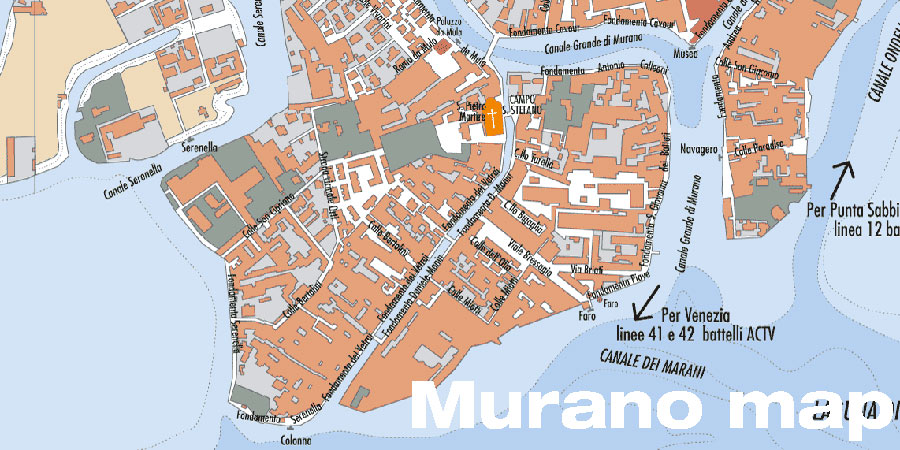The Murano Island is usually described as an island in the Venetian Lagoon, although like Venice itself it is actually an archipelago of islands linked by bridges.
It lies about a mile north of Venice and is famous for its glass making, particularly lampworking. It was once an independent comune, but is now a town of the comune of Venice.
Today, Murano is home to the Museo Vetrario or Glass Museum in the Palazzo Giustinian, which holds displays on the history of glassmaking as well as glass samples ranging from Egyptian times through the present day.
Some of the historical glass factories in Murano are now among the most important brands of glass in the world. The oldest glass factory is Antica Vetreria Fratelli Toso, founded in 1854. Some of the Murano's historical glass factories remain today as well known brands, amongst them Venini, Barovier & Toso, Pauly, Seguso and Simone Cenedese.
Murano Island Map to download
Click on the photo to download a map of the island of Murano in the Venice lagoon.
Where to buy glass?
The 10 best glass shops in Murano
- Guarnieri Glass Factory (Fondamenta Serenella 3/4, 30141 Murano): Art gallery. Spectacular shop with honest prices for original handmade Murano glass objects.
- New Murano Gallery (Alvise Vivarini 6A, 30141 Murano): Art gallery. Specialty and gift shops. Guided tour of the glass factory.
- B.F. Signoretti (San Cipriano 48, 30141 Murano): Outlet.
- Mazzega Glass Factory (Fondamenta da Mula 147, 30141 Murano): Art gallery. Impressive works.
- Gino Mazzuccato Murano Glass (Fondamenta Daniele Manin 1, 30141 Murano): Art gallery. Specialty and gift shops. The demonstration was very interesting and engaging and at a reasonable cost.
- Studio-Gallery of Luigi Camozzo (Fondamenta Sebastiano Venier 3, 30141 Murano): Interesting visit to the Studio-Gallery. Beautiful compositions, beautiful colors, real art.
- Berengo Studio 1989 (Fondamenta dei Vetrai 109A): Art gallery.
- Massimiliano Schiavon Art Team (Fondamenta Serenella 18A, 30141 Murano): Specialty and gift shops.
- Alessandro Mandruzzato, Unique Murano Glass (Fondamenta Andrea Navagero 54B, 30141 Murano): Art gallery. Artistic objects of the highest quality and fine workmanship.
- Vetreria Murano Arte - VMA (San Cipriano 48/1, 30141 Murano): Art gallery.
History of Murano Glassmaking
It is believed that glassmaking in Murano originated from 9th century Rome, with significant Asian and Muslim influences, as Venice was a major trading port. Murano’s reputation as a centre for glassmaking was born when the Venetian Republic, fearing fire and destruction to the city’s mostly wooden buildings, ordered glassmakers to move their foundries to Murano in 1291. Murano glass is still interwoven with Venetian glass.
Murano's glassmakers were soon the island’s most prominent citizens. By the 14th century, glassmakers were allowed to wear swords, enjoyed immunity from prosecution by the Venetian state and found their daughters married into Venice’s most affluent families. However glassmakers were not allowed to leave the Republic. Many craftsmen took this risk and set up glass furnaces in surrounding cities and as far afield as England and the Netherlands.
By the end of the 16th century, three thousand of Murano island's seven thousand inhabitants were involved in some way in the glassmaking industry.
Murano’s glassmakers held a monopoly on quality glassmaking for centuries, developing or refining many technologies including crystalline glass, enamelled glass (smalto), glass with threads of gold (aventurine), multicoloured glass (millefiori), milk glass (lattimo), and imitation gemstones made of glass. Today, the artisans of Murano are still employing these century-old techniques, crafting everything from contemporary art glass and glass figurines to Murano glass chandeliers and wine stoppers.
The Art of Glassmaking
The process of making Murano glass is rather complex. Most Murano glass art is made using the lampworking technique. The glass is made from silica which becomes liquid at high temperatures. As the glass passes from a liquid to a solid state, there is an interval when the glass is soft before it hardens completely. This is when the glass-master can shape the material.
Colours, techniques and materials vary depending upon the look a glassmaker is trying to achieve. Aquamarine is created through the use of copper and cobalt compounds whereas ruby red uses a gold solution as a colouring agent. Murrine technique begins with the layering of colored liquid glass, which is then stretched into long rods called canes (see caneworking). When cold, these canes then sliced in cross-section, which has the layered pattern. The better-known term "millefiori" is a style of murrine that is defined by each layer of molten color being shaped by a mold into a star, then cooled and layered again. When sliced, this type of murrine has many points thus mille (thousand). Filigree a type of caneworking, incalmo, enamel painted, engraving, gold engraving, lattimo, ribbed glass and submersion are just a few of the other techniques a glassmaker can employ.




